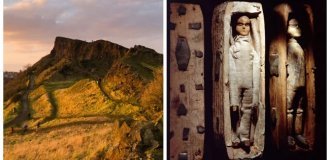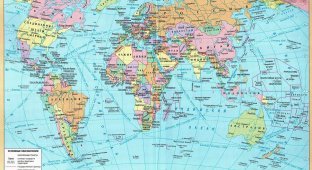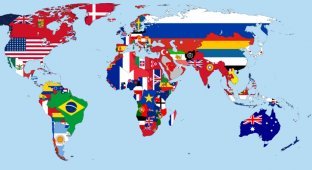Unusual cards (40 photos)
Monsters devouring ships, dangerous currents and other joys of the first navigators, who also knew how to draw in their free time from their shifts.
When we were small children, who among us did not draw maps and plans ourselves? Who hasn’t played with a geographical map while reading books about pirates and sailors? Who hasn't dreamed of visiting Australia or discovering their own island? Now you can buy the island, but you can’t return those impressions, it would seem... I’ll try to do it!

This is a map of the world according to Posidonius, around 150-130 BC.


These 16th-century Portuguese maps are considered to be among the earliest depictions of the Americas. There are Brazil, Florida, and the Caribbean islands.

Fragment: Europe and Jerusalem

Fragment: Caribbean islands

An original vision of the world from Petro Sollo in 1520, when a certain Dragon`s Tail was issued from Asia to the Indian Ocean

Here is a large map of the city of Venice showing most of the major buildings from 1565. Maps in this style are still quite often used on tourist postcards and city guides:

The ornate Marina Charter, dated 1539, may seem rather crude by today's standards, but modern satellite imagery has revealed that sea monsters in parts of the ocean on the map actually correspond to well-known storm fronts, dangerous currents and other marine hazards. This was only possible by the method of depicting the corresponding processes at that time (I talked about something similar with someone, touching on the importance of studying alchemy for a psychologist, if he wants to be not a piece of shit, although he is a member of United Russia, but an expensive professional):

This is similar, indicating monsters living in the seas around Iceland in the early sixteenth century:

This is literally a catalog of sea monsters and other fantasies of sailors of that time, when their diet included herbal drugs and other goodies.






and finally: a whale like an island! - Published in Orbis Indiae OCCIDENTALIS, 1621:

Various incarnations in "Land Down Under" including... undiscovered Antarctica
The southern part of the globe would be some of the last new lands to be charted by Europeans after the Age of Discovery, but the idea of 'Terra Australis' had lived on since the time of Aristotle in the fourth century BC. There were various theories about this - it was even assumed that there must have been some lands in the south in order to “balance the planet.” Antarctica was finally discovered in 1820, but here are maps of the mythical continent occupying a significant part of the southern hemisphere from 1587:


These highly decorative maps of the world, with Antarctica as well as parts of North America still missing, were produced in Amsterdam in 1689.


Here is an Italian map of North America from 1566; one of the first descriptions of the northernmost part of Canada:

Alternative history in hypothetical maps
In this version, the Germans won, but disdained Finland. It’s clear that she seems to be an ally, but maybe they knew something?!

This is an illustration for a 1964 book based on the assumption that the Germans had won. Based on the map legend, neutral territories are marked in blue, i.e. No one needed Siberia, which in principle is still happening in reality.


This is a classic vision of the world alignment according to Orwell in his 1984.

Back in the seventies, K. Etzel Pearcy, a professor of geography, proposed redrawing the boundaries of American states. The country was planned to consist of thirty-eight states rather than fifty, with new names to reflect physical and cultural identities. The idea was not implemented, as we know, of course, but it is very intriguing. And tell me, did any of you know about this?!

The same theme played out in advertising.

To the previous picture - here is a map of Mexico with the very territories that they later lost to the United States.

Africa is like one large territory of colonies. Not the worst time for her, no joke.

Colonial possessions of England.

Robert Dighton's cartoon map of England from 1795:

Here are some similar maps from the late nineteenth and early twentieth centuries. This is an Asian view of the world situation during the Chinese Revolution of 1912. This map was actually published in Japan, but indicates that there was a lot of foreign influence on China.

Shortly before the outbreak of the First World War, the Russian bear simply loomed over Europe and Asia, Great Britain is portrayed as a sea monster, reflecting the position of the country with the predominant sea power in the world (at that time), while Germany is nothing more than a sullen warthog:

This is a pretty famous card, but I'll stick it in to remind you.

The so-called "Octopus" card, released a few years later. At that time, the Russian Empire was generally seen as very expansionist and already having its tentacles around Turkey and Persia, but turning its back on Germany:

This Octopus is a little more badass.
Like the “Hand of Moscow” from the time of victory in World War II.

"Lord of the Rings" style map.

This is one of the options for an unusual view of the world.
























